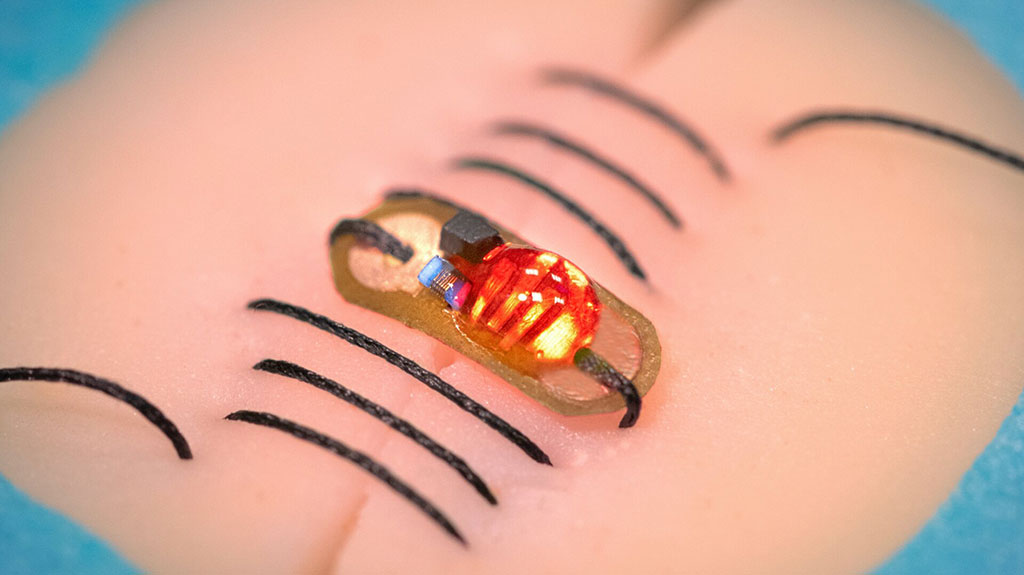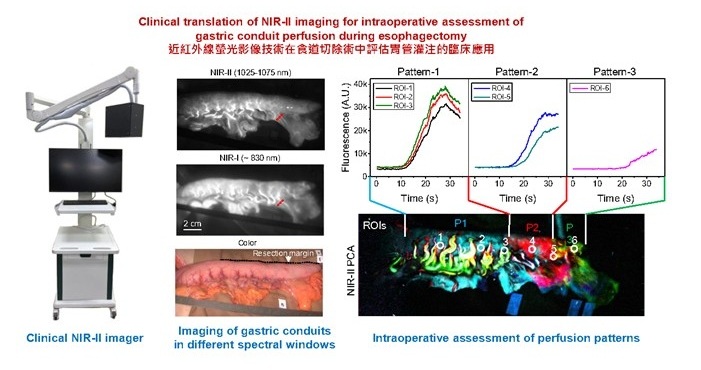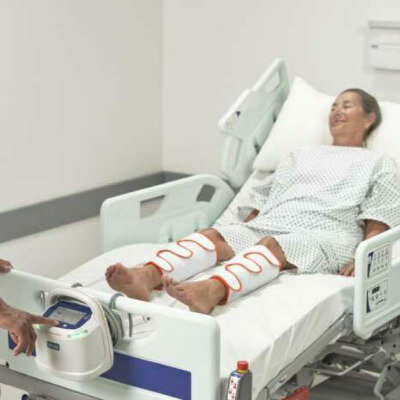Bioelectronic Sutures Monitor Deep Surgical Wounds
|
By HospiMedica International staff writers Posted on 17 Jan 2022 |

Image: Smart surgical sutures with an attached electronic RFID monitoring module (Photo courtesy of NUS)
Battery-free, wireless smart sutures can promote healing and monitor wound integrity, gastric leakage, and tissue micro-motion at the same time, claims a new study.
Developed at National University of Singapore (NUS; Singapore), the new sutures have three key components: a medical-grade multifilament silk suture coated with a conductive polymer to allow it to respond to wireless signals; a battery-free electronic capacitive sensor; and an external wireless reader used to communicate with the suture. During stitching of the wound, the insulating section of the suture is threaded through the electronic module and secured by applying medical silicone to the electrical contacts.
The entire surgical stitch functions as a radio-frequency identification (RFID) tag that can be read by an external reader. The smart sutures can be read up to a depth of 50 mm, depending on the length of stitches involved, and are also able to alert clinicians if they are broken or unraveled, for example by dehiscence of the wound. Similar to existing sutures, clips, and staples, the smart sutures can be removed post-operatively via a minimally invasive procedure when risk of complications has passed. The study was published in the December 2021 issue of Nature Biomedical Engineering.
“Currently, post-operative complications are often not detected until the patient experiences systemic symptoms like pain, fever, or a high heart rate,” said senior author John Ho, PhD, of the NUS department of Electrical and Computer Engineering. “These smart sutures can be used as an early alert tool to enable doctors to intervene before the complication becomes life-threatening, which can lead to lower rates of re-operation, faster recovery, and improved patient outcomes.”
Related Links:
National University of Singapore
Developed at National University of Singapore (NUS; Singapore), the new sutures have three key components: a medical-grade multifilament silk suture coated with a conductive polymer to allow it to respond to wireless signals; a battery-free electronic capacitive sensor; and an external wireless reader used to communicate with the suture. During stitching of the wound, the insulating section of the suture is threaded through the electronic module and secured by applying medical silicone to the electrical contacts.
The entire surgical stitch functions as a radio-frequency identification (RFID) tag that can be read by an external reader. The smart sutures can be read up to a depth of 50 mm, depending on the length of stitches involved, and are also able to alert clinicians if they are broken or unraveled, for example by dehiscence of the wound. Similar to existing sutures, clips, and staples, the smart sutures can be removed post-operatively via a minimally invasive procedure when risk of complications has passed. The study was published in the December 2021 issue of Nature Biomedical Engineering.
“Currently, post-operative complications are often not detected until the patient experiences systemic symptoms like pain, fever, or a high heart rate,” said senior author John Ho, PhD, of the NUS department of Electrical and Computer Engineering. “These smart sutures can be used as an early alert tool to enable doctors to intervene before the complication becomes life-threatening, which can lead to lower rates of re-operation, faster recovery, and improved patient outcomes.”
Related Links:
National University of Singapore
Latest Critical Care News
- AI-Enhanced Wearables Could Transform Type 2 Diabetes and Prediabetes Care
- Breathable Electronic Skin Paves Way for Next-Generation Wearable Devices
- AI Transforming Colon Cancer Diagnosis
- Ventricular Assist Device Offers Long-Term Use in Children Waiting for Donor Heart
- Precision Approach Improves Immunotherapy Effectiveness for ICU Patients with Sepsis
- Soft Robots Could Donate Their Heart to Humans
- Bioadhesive Strategy Prevents Fibrosis Around Device Implants on Peripheral Nerves
- Miniature Non-Invasive Robotic Catheters to Improve Infertility Treatments
- Stick-On Patch Monitors Baby's Movements In Utero
- EEG-Based AI Technology Accurately Diagnoses Alzheimer’s and Dementia
- Robot Lymphatic System Paves Way for Self-Powered Wearables and Machines
- Focused Ultrasound Technique Successfully Treats Pediatric Brain Cancer
- Nasal Drops Fight Brain Tumors Noninvasively
- AI Helps Optimize Therapy Selection and Dosing for Septic Shock
- Glowing Bacteria ‘Pills’ for Detecting Gut Diseases Could Eliminate Colonoscopies
- Skin-Permeable Polymer Patch Delivers Insulin Non-Invasively Through Skin
Channels
Surgical Techniques
view channel
3D-Printed Blood Vessel Scaffolds Could Transform Heart Bypass Surgeries
A tiny, opaque tube held up in a lab may look unremarkable at first glance, but its microscopic surface features could mark a meaningful step forward in heart bypass surgery. Measuring just about one centimeter... Read more
Novel Imaging Technique Helps View Blood Perfusion During Esophageal Surgery
Esophagectomy is a complex and high-risk surgery often required for esophageal cancer, with anastomotic leakage remaining one of its most serious complications. This defect at the surgical suture line... Read more
Minimally Invasive Surgery Proven Safe and Effective for Complex ‘Whipple’ Procedure
Tumors of the pancreatic head often require a highly complex operation known as pancreatoduodenectomy or the Whipple procedure. This surgery involves removing multiple structures and creating several internal... Read more
Catheter-Based Procedures Offer Less Invasive Option for Treatment of Valvular Disease
Valvular heart disease, caused by tight or leaky valves between heart chambers, affects up to 10% of older adults and leads to more than 120,000 deaths globally each year. Traditional open-heart surgery... Read morePatient Care
view channel
Revolutionary Automatic IV-Line Flushing Device to Enhance Infusion Care
More than 80% of in-hospital patients receive intravenous (IV) therapy. Every dose of IV medicine delivered in a small volume (<250 mL) infusion bag should be followed by subsequent flushing to ensure... Read more
VR Training Tool Combats Contamination of Portable Medical Equipment
Healthcare-associated infections (HAIs) impact one in every 31 patients, cause nearly 100,000 deaths each year, and cost USD 28.4 billion in direct medical expenses. Notably, up to 75% of these infections... Read more
Portable Biosensor Platform to Reduce Hospital-Acquired Infections
Approximately 4 million patients in the European Union acquire healthcare-associated infections (HAIs) or nosocomial infections each year, with around 37,000 deaths directly resulting from these infections,... Read moreFirst-Of-Its-Kind Portable Germicidal Light Technology Disinfects High-Touch Clinical Surfaces in Seconds
Reducing healthcare-acquired infections (HAIs) remains a pressing issue within global healthcare systems. In the United States alone, 1.7 million patients contract HAIs annually, leading to approximately... Read moreHealth IT
view channel
EMR-Based Tool Predicts Graft Failure After Kidney Transplant
Kidney transplantation offers patients with end-stage kidney disease longer survival and better quality of life than dialysis, yet graft failure remains a major challenge. Although a successful transplant... Read more
Printable Molecule-Selective Nanoparticles Enable Mass Production of Wearable Biosensors
The future of medicine is likely to focus on the personalization of healthcare—understanding exactly what an individual requires and delivering the appropriate combination of nutrients, metabolites, and... Read moreBusiness
view channel
Philips and Masimo Partner to Advance Patient Monitoring Measurement Technologies
Royal Philips (Amsterdam, Netherlands) and Masimo (Irvine, California, USA) have renewed their multi-year strategic collaboration, combining Philips’ expertise in patient monitoring with Masimo’s noninvasive... Read more
B. Braun Acquires Digital Microsurgery Company True Digital Surgery
The high-end microsurgery market in neurosurgery, spine, and ENT is undergoing a significant transformation. Traditional analog microscopes are giving way to digital exoscopes, which provide improved visualization,... Read more
CMEF 2025 to Promote Holistic and High-Quality Development of Medical and Health Industry
The 92nd China International Medical Equipment Fair (CMEF 2025) Autumn Exhibition is scheduled to be held from September 26 to 29 at the China Import and Export Fair Complex (Canton Fair Complex) in Guangzhou.... Read more












